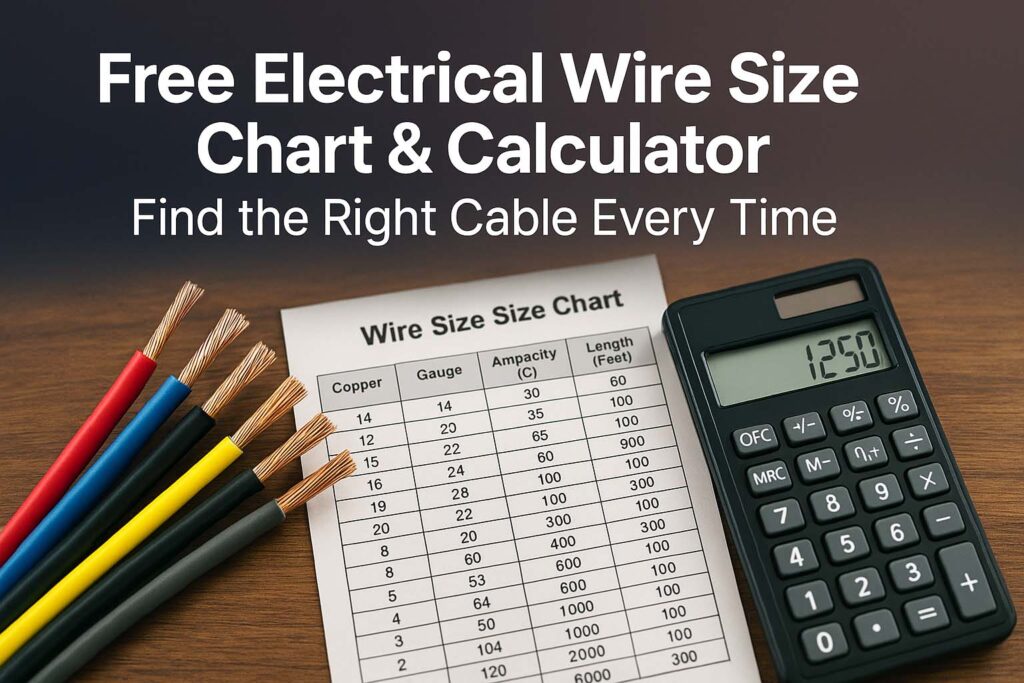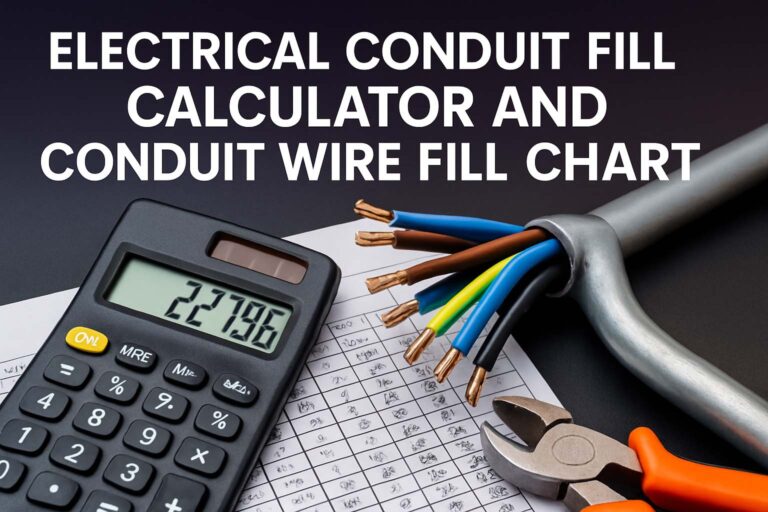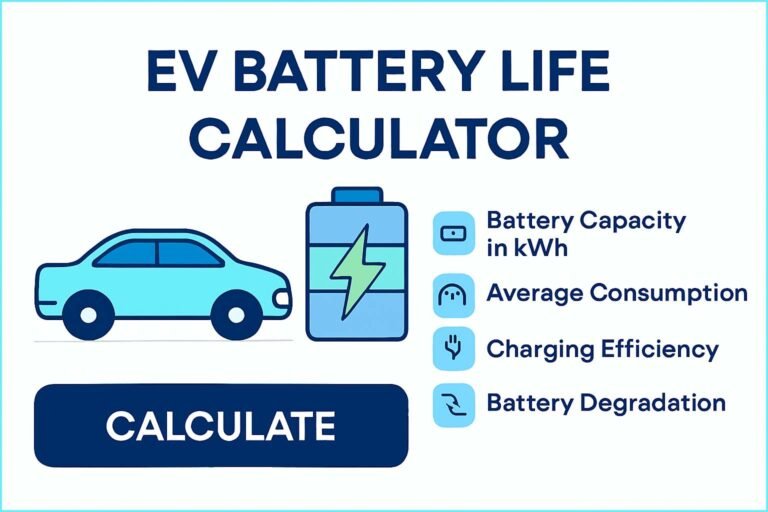Free Electrical Wire Size Chart & Calculator – Find the Right Cable Every Time
Choosing the correct wire size is one of the most important steps in any electrical installation. Whether you’re wiring a home circuit, connecting an air conditioner, or installing a solar system, undersized cables can cause voltage drops, overheating, and even fire hazards. That’s where a free electrical wire size chart and a reliable cable size calculator become indispensable.
Table of Contents
Table of Contents

In this article, we’ll break down how to use a wire size chart, explain how our electric wire calculator works, and give you the technical insights you need to make the right decision every time.
Key Takeaways:
- Understand how wire size affects electrical performance and safety
- Use our free cable size calculator to select the correct wire every time
- Learn about ampacity, voltage drop, and insulation types
- Discover how temperature and distance impact wire gauge
- Includes a complete wire size chart for easy reference
Why Wire Size Matters in Electrical Installations
Every conductor has resistance. The thinner the wire, the more resistance it offers to electrical current. This resistance leads to heat and voltage drops. If not managed properly, it can reduce equipment performance or create fire risks.
The wire size is determined primarily by:
- Current (Amps) flowing through the wire
- Voltage of the circuit
- Distance from the power source
- Allowable Voltage Drop (usually 3–5%)
- Type of load (resistive or inductive)
- Temperature Rating and Installation Conditions
Know more about Online Wire Gauge Calculator for 1 Phase and 3 Phase Load
Free Electrical Wire Size Calculator
The National Electrical Code (NEC) and IEC standards both provide guidelines for safe wire sizing. These standards form the basis for most reliable wire size calculators and charts.
Understanding the Basics: Key Terms
Before jumping into the chart or calculator, here are a few essential terms you’ll encounter:
- Ampacity: Maximum amount of electrical current a conductor can carry safely
- AWG (American Wire Gauge): Standard for measuring wire diameter in North America
- Voltage Drop: The reduction in voltage as electric current flows through the conductor
- Conductor Material: Copper or Aluminum – copper has higher conductivity
- Single-phase or Three-phase: Impacts the formula used for sizing wires
These factors all influence the correct choice of wire gauge.
Free Electrical Wire Size Chart for Copper Conductors
This wire size chart is based on copper wires with 75°C insulation in conduit, using standard ampacity values as per NEC:
| Wire Gauge (AWG) | Maximum Amps | Common Uses |
|---|---|---|
| 14 AWG | 15 A | Lighting circuits |
| 12 AWG | 20 A | Small appliance outlets |
| 10 AWG | 30 A | Air conditioners, dryers |
| 8 AWG | 40 A | Electric ovens, small subpanels |
| 6 AWG | 55 A | Feeders, large appliances |
| 4 AWG | 70 A | Large subpanels, EV chargers |
| 2 AWG | 95 A | Main feeders, industrial loads |
| 1/0 AWG | 150 A | Main service entrances |
| 4/0 AWG | 230 A | High-capacity panels |
This chart gives a quick idea of what size to use. However, for longer distances or non-standard conditions, it’s best to use a cable size calculator.
Use our free online tool What Gauge Wire Do I Need? Free Online Calculator for Electricians & Homeowners
How to Use the Cable Size Calculator
Our electric wire calculator is designed to take the guesswork out of wire sizing. It calculates the correct wire gauge based on:
- Load Current (in Amps)
- Supply Voltage (e.g., 120V, 230V, 400V)
- Distance (in meters or feet)
- Phase Type (single or three-phase)
- Conductor Material (copper or aluminum)
- Voltage Drop Limit (typically 3% or 5%)
Formula for Voltage Drop in Single-Phase Circuits
Voltage Drop (V) = 2 × Length × Current × Resistance / 1000
For Three-Phase Circuits
Voltage Drop (V) = √3 × Length × Current × Resistance / 1000
The calculator uses internal resistance values for copper or aluminum and recommends a wire gauge accordingly.
Example: Choosing the Right Wire Size
Let’s say you have a single-phase 230V load pulling 25 amps, and the distance between the panel and the load is 40 meters. You allow a 3% voltage drop.
The cable size calculator will process these inputs and return:
- Required minimum wire size: 6 AWG Copper
- Voltage drop: Within acceptable range (~2.88%)
- Ampacity check: 6 AWG supports up to 55 A, so it’s safe
This ensures your load gets sufficient voltage and stays within thermal limits.
Factors That Affect Wire Size Selection
While current is the primary driver, other factors can change your wire sizing:
1. Distance
Longer wires increase resistance. For every extra 10 meters, consider checking the voltage drop. This is especially important in solar, farm, and warehouse wiring.
Use our free online tool NEC Wire Size Calculator – Voltage Drop Compliant Sizing for 120V & 240V Circuits
2. Temperature
If the wire is in a hot area (e.g., attic or factory), its ampacity decreases. You may need to upsize by 1 or 2 gauges to stay safe.
3. Grouping of Cables
When multiple wires are bundled in one conduit, they generate more heat. NEC tables provide derating factors in such cases.
4. Load Type
Motors and inductive loads like HVAC compressors require larger wires to handle startup currents. Resistive loads like heaters do not.
5. Voltage System
Three-phase systems use less current than single-phase for the same power level. This often allows for smaller wires, making them more efficient for industrial setups.
Choosing Between Copper and Aluminum Cables
Copper is more conductive and durable, but aluminum is lighter and cheaper. For long-distance or budget installations, aluminum is often used with a slightly larger size to compensate.
| Property | Copper | Aluminum |
|---|---|---|
| Conductivity | High | Moderate |
| Size Required | Smaller | Larger |
| Cost | More expensive | More economical |
| Weight | Heavier | Lighter |
| Durability | Higher | Slightly lower |
If you’re using aluminum, make sure connections are tightened and oxidation-protected.
Use our free online tool Wire Size Calculator by Load and Length – Accurate Amp Sizing for Home Wiring
Voltage Drop Tolerance Guide
| Circuit Type | Max Voltage Drop |
|---|---|
| Lighting Circuits | 3% |
| Motor Circuits | 5% |
| Residential Wiring | 3–5% |
| Industrial Systems | 3% (preferably) |
Always aim for lower voltage drop to improve efficiency and reduce wear on appliances.
Applications of the Wire Size Calculator
The electric wire calculator is ideal for:
- Home electricians and DIYers
- Electrical contractors and engineers
- Solar panel installers
- Factory and farm wiring systems
- EV charging station setup
- Generator and backup power planning
Using it reduces costly errors, ensures compliance, and boosts the overall safety of your electrical system.
When Should You Use the Wire Size Chart Instead?
Charts are quick and useful for short, simple runs. If you’re wiring a socket in your home or a light fixture, the wire size chart gives you fast answers. However, for anything beyond 10 meters or above 20 amps, always verify with a cable size calculator.
Use our free online tool Solar System Sizing Calculator for Agriculture & Tubewells
Conclusion: Combine the Power of Charts and Calculators
You don’t need to be an electrical engineer to choose the right wire size. With this free electrical wire size chart and cable size calculator, you’ll have everything you need at your fingertips. Make smarter, safer choices, reduce your energy loss, and protect your equipment investment.
For best results, always double-check longer runs or high-load circuits with the electric wire calculator. And keep the wire size chart handy for fast, everyday references.
Follow Us on Social:
Subscribe our Newsletter on Electrical Insights to get the latest updates in Electrical Engineering.
#wiresizechart, #cablesizecalculator, #electricwirecalculator, #electricalwiring, #cablesizing, #homewiringguide, #electricalengineering, #wiringsafety, #loadcalculation, #wiresizeguide, #ampsizing, #voltdropcalculator, #electriccablechart, #residentialwiring, #DIYelectrical
Free Electrical Wire Size Chart & Calculator – Find the Right Cable Every Time : Electrical Engineering Hub

Use our free Electrical Wire Size Chart & Calculator to find the perfect cable size for any load or distance. Ensure safe, efficient wiring with accurate wire gauge, current capacity, and voltage drop results
Price Currency: USD
Operating System: All
Application Category: UtilitiesApplication





